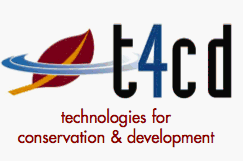Wednesday, January 25, 2006
The audience
Peter Hall

Director of Biodiversity Information Services at UNEP-WCMC, and lepidopterist, gave us the conservation perspective and used a butterfly to make his point.
A busy day

But there's time for a quick sandwich at lunch, as Ken shows.
From the chair
But while the others are working on their proposals I have a few minutes spare to post some thoughts on yesterday, culled largely from Zoe's notes [for which many thanks!]
Sunday, January 15, 2006
Introduction to Tracking
The commercial development of vehicle and asset-tracking devices provides further insight, along with the huge potential of RFID (Radio Frequency Identification) tagging - something still very much in its infancy but believed to be the 'next big' thing in the technology world.
The Biometrics approach, with the potential application of image recognition technologies, developed in the first instance as security tools (iris/ear lobe/gait recognition etc), to the monitoring of individual animals such as elephants, is another area worth watching.
What do you think? Please use the comments feature to let us know and help to shape our discussion.
Introduction to Remote Power
However, while energy supply is a real issue, it's not the only one - energy efficiency is a key component in the mix, and energy efficient devices with a range of power-saving options can extend the life of a single-charge considerably. Of course, field-based workers still have the options of solar power, portable generators and wind-up chargers, but some of these are not only bulky and impractical in many instances, many are also expensive. With ICT playing an ever-increasing role in global conservation and development work, the problem of powering and charging mobile devices - GSM phones, handheld GPS units, satellite phones, cameras and laptops - becomes all the more acute, and a challenge that more are beginning to face.
What do you think? Please use the comments feature to let us know and help to shape our discussion.
Introduction to GIS and Remote Sensing
Software packages such as ArcView provide a standard by which the data can be stored and shared, and numerous organisations, from the UNEP to local wildlife authorities, provide GIS databases for public use.
Participatory GIS is of particular relevance in instances where there is clear potential for local communities living in or around conservation areas to engage in data collection. The size and usability of handheld GPS and data collection devices is crucial in such cases, and underlines the importance of innovations such as CyberTracker. Access to higher-end GIS management systems such as ArcView and Google Earth are still highly restricted, however. Making GIS data collection more widely available to stakeholders, and more relevant to them and their circumstances, are challenges which still need to be faced.
What do you think? Please use the comments feature to let us know and help to shape our discussion.
Introduction to Mobile Communications
While satellite communication devices are generally out of reach for many due to cost - although they continue to come down in price - mobile phone uptake has been phenomenal; not least in developing countries where it is seen as a 'leapfrogging' technology and one which is helping close the digital divide. Mobile phones and satellite communication devices have huge potential to enhance conservation & development work, particularly given the numerous tools that can be integrated into such devices - many are enabled with mobile internet, text messaging, picture messaging, cameras and a variety of operating systems and software - but how best do we make use of this potential?
GSM's ability to cross over into conservation disciplines, such as wildlife tracking, is just one example of how adaptable and flexible the technology can be, and as more and more devices converge - as we have seen with the development of camera phones and GSM-enabled PDA's - the greater the opportunities become.
What do you think? Please use the comments feature to let us know and help to shape our discussion.
What the conference will do
We will focus our attention on four separate but overlapping areas:
In the morning each area will be discussed by a group who will then present their ideas and conclusions to everyone, and then we'll spend the afternoon coming up with an action plan for how to take things forward after the conference.
We're posting short summaries of each of the four areas as a starting point for our discussion - these will also be provided to delegates at the start of the event.
Sunday, January 08, 2006
Some background reading on t4cd
In 2003 Ken Banks, one of the organising team behind the conference, was contracted as the Technical Advisor on a one-year Vodafone Group Foundation-funded project to investigate the potential for mobile telephony to be used in the promotion and support Flora and Fauna International's global conservation work.
One result is t4cd.
During field and desk-based research for t4cd, a report was written: 'Mobile telephony: An appropriate tool for conservation and development?'. Co-authored by Ken Banks and Richard Burge, the Vodafone Group Foundation provided additional funding and the report was published in November 2004.
You can download a PDF of the first nine pages of the report (courtesy of FFI)
Monday, January 02, 2006
Welcome to the t4cd conference blog
Ultimately this high-profile “brain-storming” event is looking for solutions: concrete opportunities that can ultimately go to market and enhance our work as conservationist. We have set up this weblog to provide a space for discussion of these issues in advance of the conference, and hope that those who can't make it to Cambridge will find it useful..
Click here for more details, here for a Registration Form (Word: 747Kb)

